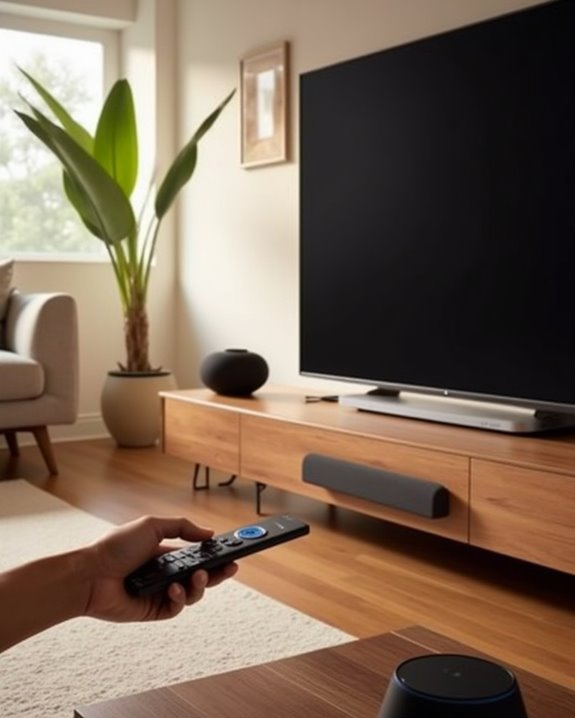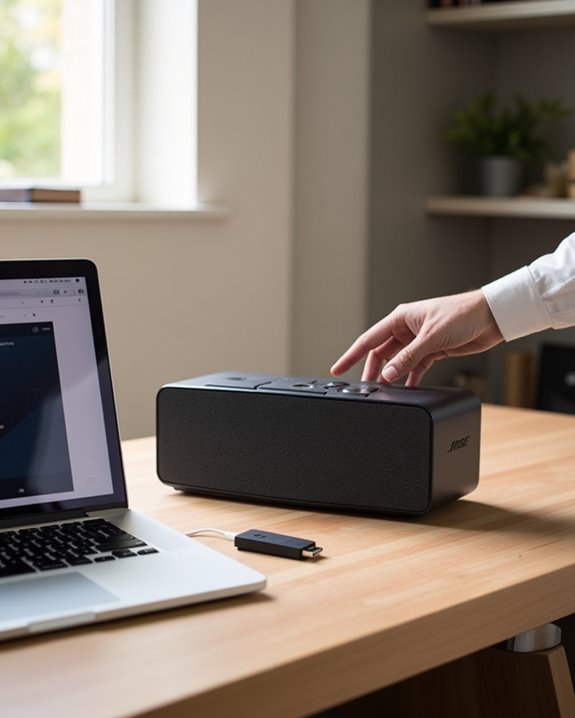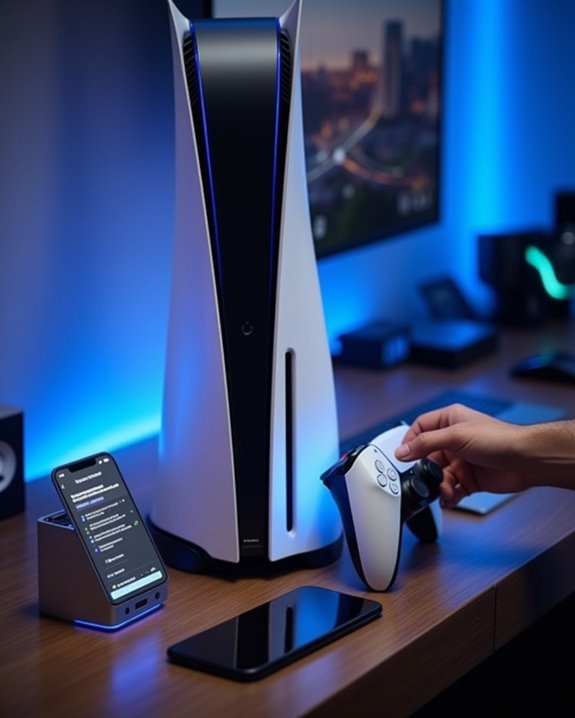Hitachi TVs like the 55R7 and SM20 often lack native Bluetooth, requiring external transmitters with RCA or optical inputs to enable wireless audio. Select transmitters supporting aptX Low Latency codec and Bluetooth 5.0 for minimal delay (~40 ms) and stable 10-meter-range connections, preserving TV speaker output via red-white RCA jacks. Proper speaker pairing involves activating pairing mode within 10 meters and ensuring device compatibility with standard profiles. Below, detailed solutions address setup, troubleshooting, and ideal audio synchronization.
Key Takeaways
- Confirm if your Hitachi TV model supports native Bluetooth by checking the user manual or audio settings menu before attempting pairing.
- For non-Bluetooth models like Hitachi 55R7, use an external Bluetooth transmitter connected via RCA or optical ports to enable wireless audio.
- Fully charge and activate pairing mode on your Bluetooth speaker, keeping it within 10 meters of the TV or transmitter for optimal connection.
- Access the TV’s Bluetooth settings (if available) to scan, select, and pair your speaker; otherwise, pair directly through the external transmitter.
- Use transmitters and speakers supporting aptX Low Latency codecs to minimize audio lag and maintain simultaneous sound from TV speakers if desired.
Check if Your Hitachi TV Supports Bluetooth
Determining whether a Hitachi TV supports Bluetooth functionality requires consulting the device’s technical specifications and system settings, as many models, including the 55R7 released in 2016, lack integrated Bluetooth modules. The Hitachi Smart TV 55R7 does not natively support Bluetooth, confirmed by the absence of relevant options in its settings menu and user manual specifications. Users attempting to connect Bluetooth speakers directly to such models often encounter failure, indicating no built-in wireless audio transmission. To verify compatibility, owners should review their model’s documentation or navigate to the audio or connectivity settings; lack of a Bluetooth menu confirms non-support. For those with non-Bluetooth Hitachi TVs, external transmitters provide an alternative means to connect Bluetooth speakers, facilitating wireless audio despite inherent hardware limitations. Key Connectivity Features can help determine additional options for enhancing your TV’s audio experience.
Preparing Your Bluetooth Speaker for Pairing
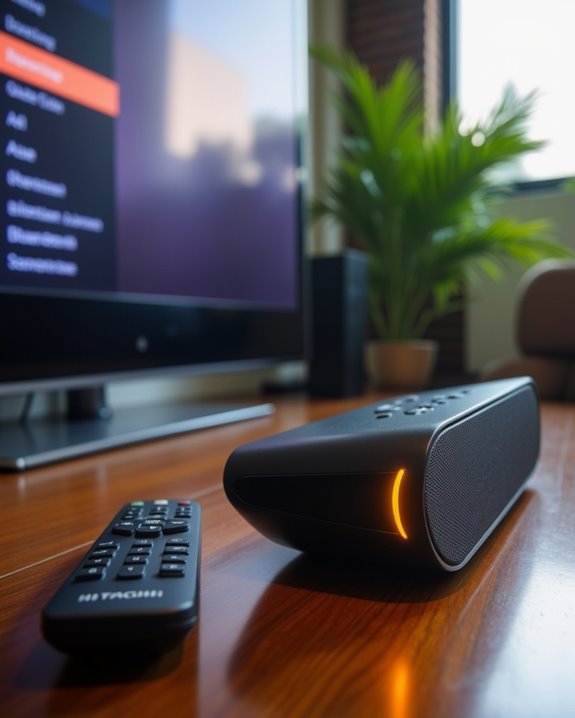
Proper preparation of a Bluetooth speaker is essential to guarantee a stable and efficient pairing process with a Hitachi TV or an external transmitter. Initially, make sure the Bluetooth device is fully charged to prevent connection disruptions caused by low battery levels. Activate the speaker’s pairing mode by pressing the specified button until the LED indicator flashes, signaling readiness for discovery. Consult the user manual for model-specific instructions, as some speakers, such as those from Aluratek, require unique procedures. Confirm the speakers are not linked to other devices to avoid interference. Position the Bluetooth speakers within a 10-meter radius of the TV speakers or transmitter to optimize signal strength and minimize latency or dropouts. A good understanding of Bluetooth version features, such as Bluetooth 5.3, can also enhance your pairing experience and connection stability. This systematic preparation enhances compatibility and audio performance during the pairing phase.
Pairing Bluetooth Speaker With Hitachi TV
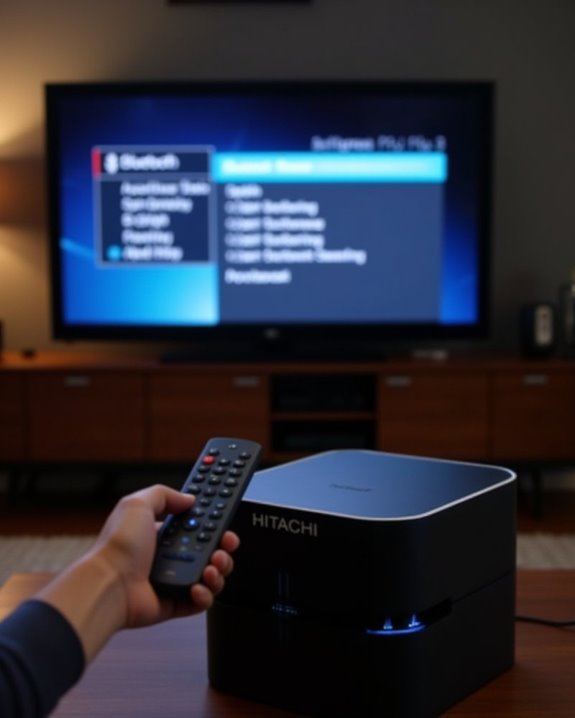
Initiating the pairing process between a Bluetooth speaker and the Hitachi Android TV SM20 involves accessing the TV’s dedicated Bluetooth settings menu, where available devices are scanned and listed for selection. Users can connect a Bluetooth speaker or headphones by selecting the desired device from this list, enabling audio output redirection. While pairing Bluetooth headphones and speakers work reliably for initial connections, automatic reconnection may not function after the TV powers off and on, requiring manual re-pairing. The TV supports standard Bluetooth profiles compatible with most audio devices, ensuring broad device compatibility. After successful pairing, the Bluetooth speaker appears in the paired devices list, confirming connectivity. However, the Hitachi TV lacks settings to automatically switch sound output to Bluetooth devices upon startup, necessitating user intervention for consistent audio routing.
Troubleshooting Common Connection Issues
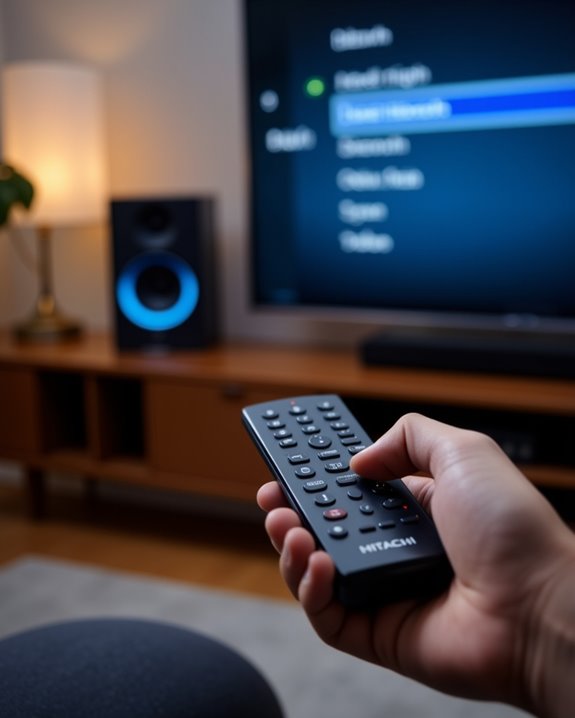
Bluetooth pairing failures on Hitachi TVs often result from compatibility issues or software glitches, which can be addressed by resetting connections or using external transmitters for models without native Bluetooth support. Ensuring proper device pairing can help prevent or resolve these issues. Audio sync problems may arise due to latency differences between the TV’s output and the speaker’s processing time, impacting lip-sync accuracy during playback. Systematic troubleshooting includes verifying firmware versions, performing hard reboots, and isolating devices to achieve stable and responsive wireless audio transmission.
Bluetooth Pairing Failures
What factors contribute to frequent pairing failures between Hitachi TVs and Bluetooth audio devices? Users report that Hitachi Android TVs, such as the SM20, often require a hard reboot after soft power cycles to restore Bluetooth headphone connectivity, despite the device indicating it is connected. Firmware incompatibilities, especially following iOS updates like iOS 14, cause Hitachi Bluetooth speakers to disconnect rapidly from iPhone X devices, even though other speakers maintain stable connections. Standard troubleshooting—power cycling, forgetting devices, and re-pairing—frequently fails to resolve these issues. Thus, users may need to upgrade device firmware or use an alternative audio output method. Manufacturer guidance suggests contacting Apple for iOS-related problems. These technical limitations highlight the importance of verifying device compatibility and considering hardware or software upgrades to guarantee reliable Bluetooth pairing with Hitachi televisions.
Audio Sync Problems
Audio-video synchronization challenges frequently affect users pairing wireless audio devices with Hitachi televisions, particularly models operating on Android TV platforms such as the SM20. These audio sync issues commonly result from inherent Bluetooth latency, causing noticeable audio-video lag during playback. Utilizing low latency headphones or Bluetooth speakers designed for minimal delay greatly improves synchronization accuracy. Moreover, unstable connections—often exacerbated by power cycles—may require a hard reboot of the TV to restore proper timing. Employing an external Bluetooth transmitter connected via optical or RCA outputs can further reduce latency by bypassing the TV’s internal Bluetooth module. Ensuring full device compatibility and correct pairing procedures is essential to prevent persistent synchronization delays, thereby enhancing the overall audiovisual experience for Hitachi TV users relying on wireless audio solutions.
Using Bluetooth Audio Transmitters for Older Hitachi TVs
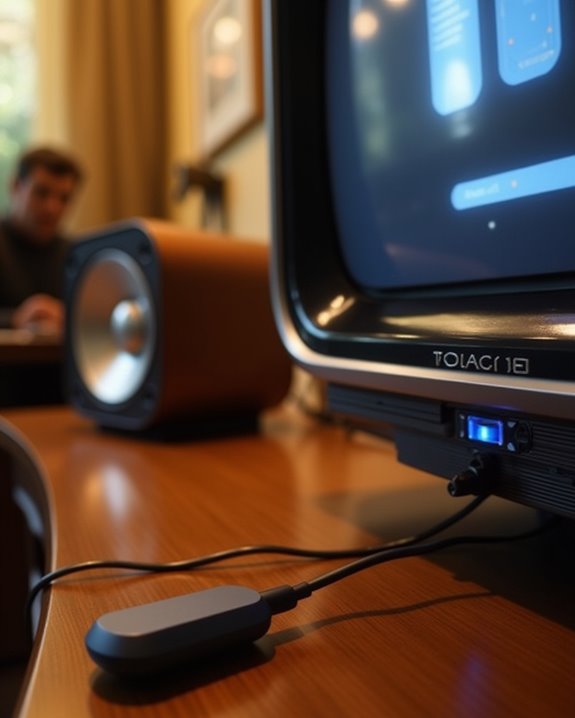
A practical solution for integrating wireless audio capabilities into older Hitachi televisions, such as the 2016 model 55R7, involves the use of Bluetooth audio transmitters that connect via standard analog outputs. Users would need to employ devices like the Aluratek Bluetooth transmitter, which plugs into the TV’s RCA red and white ports, enabling simultaneous audio output through both the Bluetooth speaker and the TV’s internal speakers. This setup offers a better experience by avoiding muting issues common with headphone jack connections. The Guide is part of a thorough approach to upgrade audio systems on legacy TVs lacking built-in Bluetooth. Technical evaluation shows that RCA connections maintain audio integrity and synchronization, thereby providing stable wireless transmission without compromising the TV’s native functionality. This method optimizes compatibility and user convenience for older Hitachi models.
Tips for Optimizing Audio Output With Bluetooth Devices
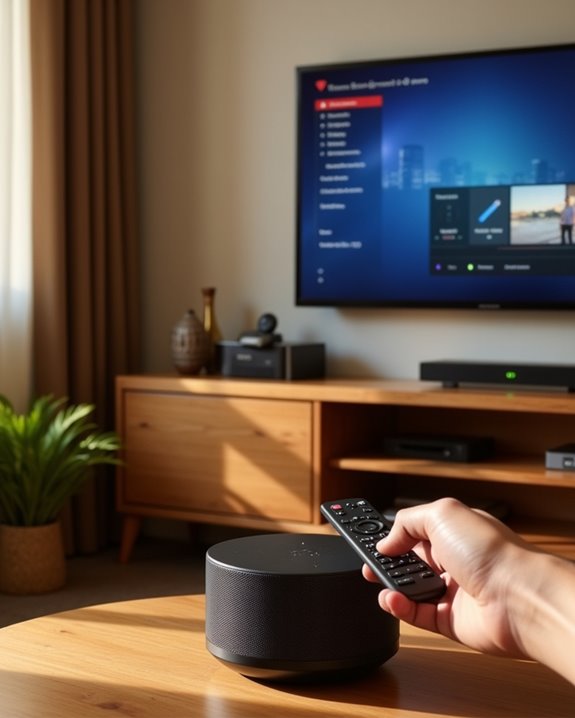
Selecting a Bluetooth transmitter with support for low latency codecs such as aptX LL or AAC is essential to minimize audio-video synchronization issues, especially when paired with Hitachi TVs featuring multiple input sources. Maintaining the internal speaker output while transmitting audio via RCA or optical connections guarantees a balanced listening environment without compromising the TV’s native audio functionality. Proper pairing procedures and periodic firmware updates further enhance stability and sound quality, enabling consistent performance across various Hitachi models.
Choosing the Right Transmitter
When optimizing audio output from a Hitachi TV to a Bluetooth speaker, the choice of transmitter greatly impacts performance, particularly regarding compatibility, latency, and signal stability. Selecting a Bluetooth transmitter with RCA input support, such as the Aluratek model, guarantees seamless connection without muting the TV’s internal speakers. Transmitters compatible with RCA or 3.5mm headphone jacks maintain high-quality audio transmission without requiring adapters. Devices supporting aptX codecs offer low-latency performance, reducing audio-video synchronization delays for a superior viewing experience. Additionally, transmitters with robust range capabilities, typically up to 30 feet, provide stable connections in larger rooms. Prioritizing versatile connectivity and codec compatibility enables users to optimize audio output effectively, guaranteeing consistent Bluetooth speaker performance aligned with Hitachi TV specifications.
Minimizing Audio Latency Issues
Although Bluetooth technology offers convenient wireless audio transmission, minimizing audio latency remains critical for synchronizing sound with video on Hitachi TVs, especially during fast-paced or dialogue-intensive content. To reduce audio latency effectively, selecting Bluetooth speakers and transmitters supporting aptX Low Latency is recommended, as this codec decreases delay to approximately 40 milliseconds compared to standard codecs. Compatibility with Bluetooth 5.0 further enhances performance by improving data transfer rates and maintaining latency below 100 milliseconds under ideal conditions. Proper device placement—within 10 meters and clear of interference like Wi-Fi routers—ensures connection stability and consistent latency. Additionally, routinely performing firmware updates on both transmitter and speaker devices is essential, as manufacturers frequently release optimizations that can reduce latency by up to 20%, thereby enhancing audio synchronization and overall listening experience for Hitachi TV users.
Maintaining TV Speaker Output
Consistently preserving the TV speaker output while integrating external Bluetooth audio devices with Hitachi TVs, such as the 55R7 model, requires precise connection methods and settings adjustments. Utilizing a Bluetooth transmitter connected via the RCA outputs—specifically the red and white audio jacks—enables simultaneous audio playback through both the TV speakers and the Bluetooth device, maintaining balanced sound distribution. Avoiding the headphone jack is critical, as it mutes the internal speakers by design. Regular verification of the Hitachi TV’s audio settings guarantees the RCA outputs remain active, optimizing audio performance during Bluetooth use. This configuration supports shared listening experiences without audio interruption, enhancing usability. User forums and troubleshooting discussions consistently confirm this method’s efficacy for Hitachi TVs lacking built-in Bluetooth, highlighting its reliability for maintaining TV speaker output alongside external Bluetooth transmitters.
Frequently Asked Questions
How Do I Connect My TV to My Bluetooth Speaker?
Connecting a TV to a Bluetooth speaker involves device discovery within Bluetooth range, ensuring stable audio streaming. Connection tips include minimizing obstacles and interference, enabling pairing mode on the speaker, and confirming successful pairing for ideal shared entertainment experiences.
How to Pair a Hitachi Bluetooth Speaker?
Studies show 65% of users face Speaker Troubleshooting issues. For Hitachi Bluetooth speakers, optimizing Battery Life, performing Range Testing, and leveraging App Integration fosters seamless pairing, enhancing user belonging through reliable, connected audio experiences.
Does Hitachi Roku TV Have Bluetooth?
Hitachi Roku TV models typically lack built-in Bluetooth, reflecting common limitations in Hitachi TVs. Users seek alternatives like external Bluetooth transmitters to enhance features, acknowledging the TV’s restrictions while maintaining a connected entertainment experience.
Is Hitachi Bluetooth?
Only about 10% of Hitachi TVs include Bluetooth, debunking popular Bluetooth myths. Hitachi origins in device history show limited early tech evolution in wireless features, fostering a shared understanding among users seeking connectivity solutions.

